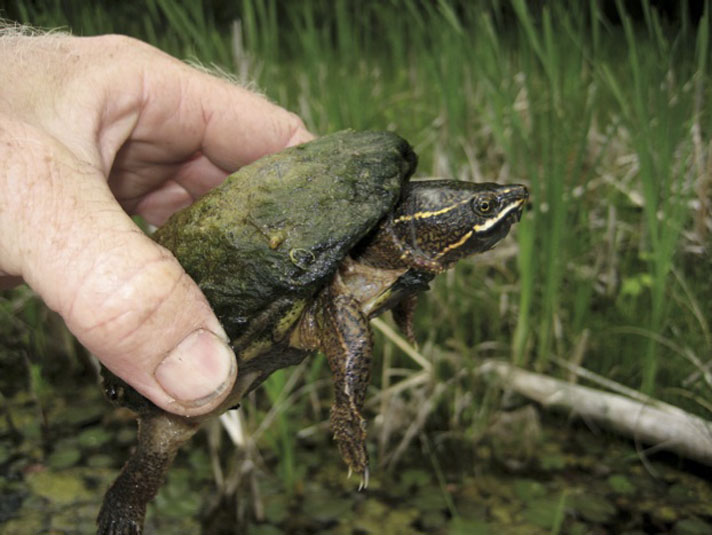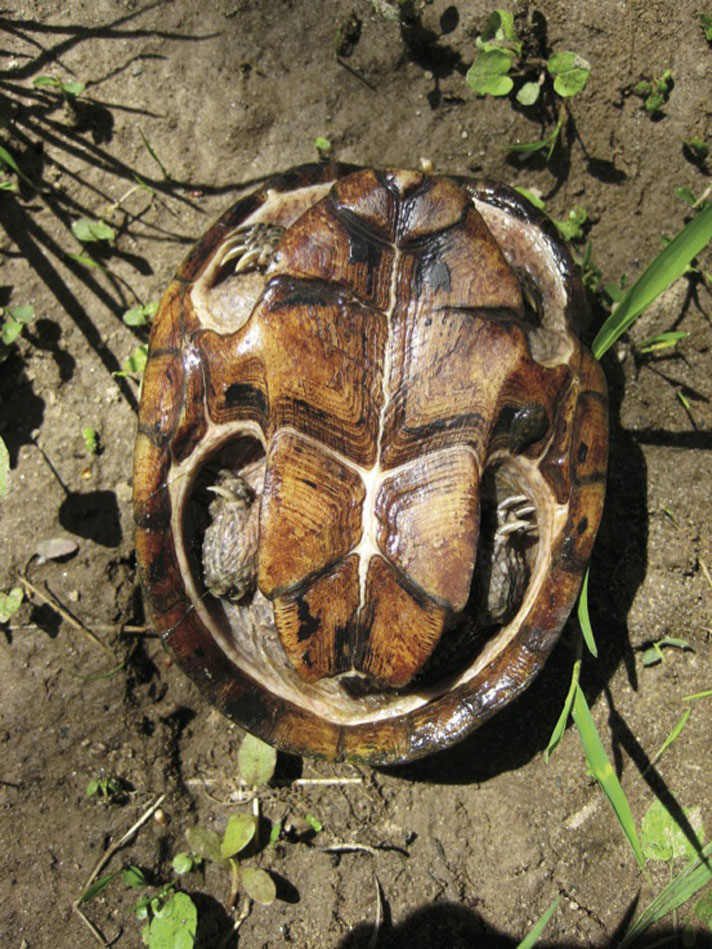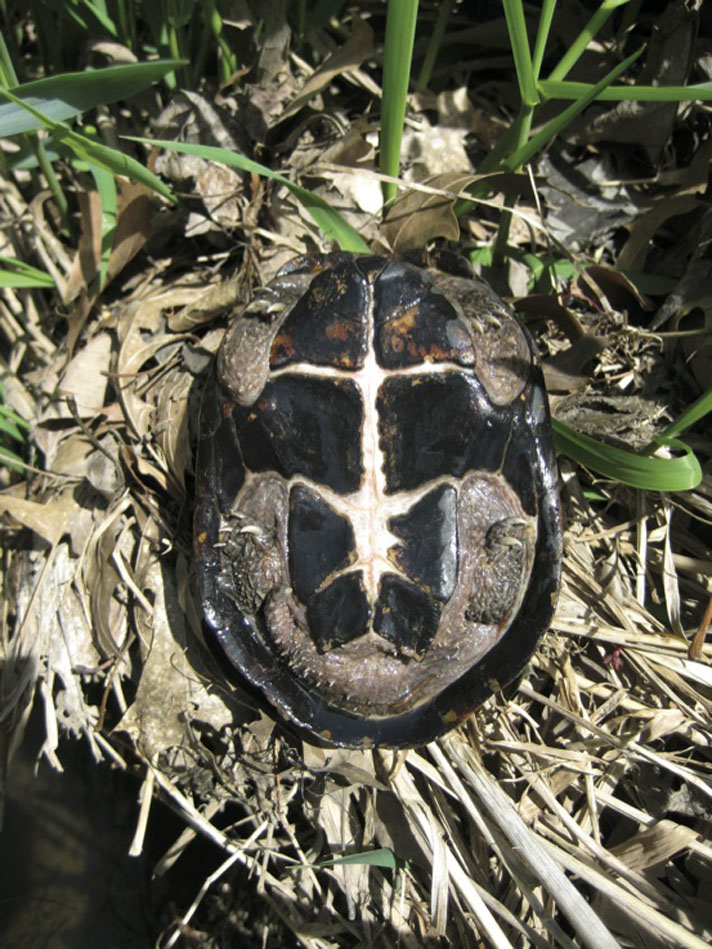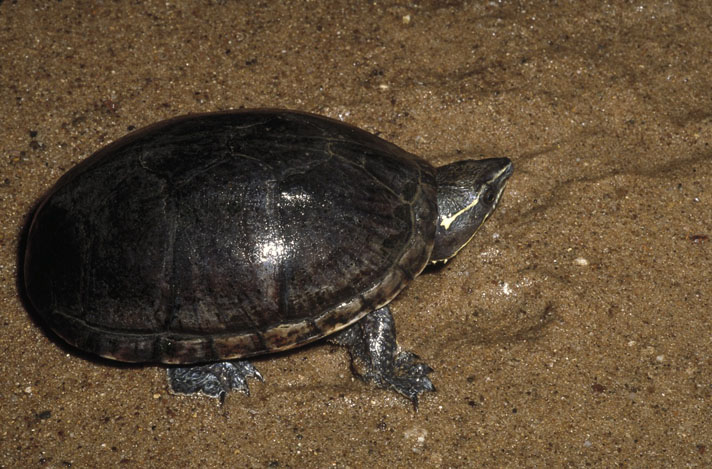These highly aquatic turtles are found in both slow-flowing sections of stream and river habitats, as well as lakes and ponds. They move clumsily on land.
With this article, I hope to introduce turtle hobbyists to a fascinating little turtle that does not often get the respect it deserves. The common musk turtle is an important denizen of lakes, ponds and streams in the eastern United States and Canada. The large range of this species illustrates its adaptability to a variety of habitats and conditions.

kurt buhlmann
A common musk turtle’s head typically has two distinct parallel yellow stripes that extend from the nose to the neck.
So how did I get introduced to the common musk turtle? As a boy growing up in a rural part of New Jersey, I found painted, snapping and box turtles to be common. I even found spotted and wood turtles in the area where I explored after school. I grew up in a little development that surrounded a man-made swimming lake with an adjacent duckweed-covered swamp and a few vernal pools in the woods. The swimming lake, which was created by damming a small stream, had been colonized by painted and snapping turtles. The spotted turtles lived in the swamp and the box turtles in the woods. The wood turtles, as I now know, were on their way out, as they had lost both their stream habitat to the lake and their adjacent riparian area to the housing development.
But I never saw a common musk turtle, which was supposed to be common in my area, according to Roger Conant’s field guide, until I was 12 years old and attending a summer camp about one hour away from where I lived. The camp had a deep, clear, naturally created glacial lake, and while out in a rowboat, I saw my first musk turtle. It moved among some lily pad stems before disappearing into the tendril-like growths of a Chara plant. Each afternoon during that week at camp, I waited impatiently for boating time, and then I actively rowed around and searched the lake edge, hoping for another musk turtle sighting. Before that week was over, the common musk turtle became the sixth turtle species that I ever captured in the wild.
Want To Learn More?
I have to admit now that it was certainly not the prettiest turtle I had ever encountered, but it was a new turtle species for me. The specimen I caught was an old adult male with a pitted, algae-covered carapace and a mottled pattern on the head. The twin bright-yellow stripes that the field guide described had faded with age. When first captured from the water—with a grab that got me in trouble with the lifeguards for being more out of the rowboat than in—the musk turtle initially retreated into its shell and behaved like a little rock. As I turned it over in my hand, I quickly became aware of a foul smell, which came from glands on the corners of the plastron that exuded an orange liquid. (Of course, I now know that the nickname, “stinkpot,” as well as the scientific name, Sternotherus odoratus, clearly refer to the chemical defense of this little turtle.)
The turtle grew bolder and more feisty, and as I held it in my hand while showing it to others in the rowboat, the little rascal slowly extended its neck a great distance around the side of its carapace, jaws open. It chomped my forefinger where it held the side of the turtle’s carapace. I dropped the turtle, and it clattered to the floor of the rowboat. Fortunately, it was unhurt, but I clearly learned the important lesson that one must always be vigilant when holding a little musk turtle!
Common Musk Turtles are Small and Spunky
Common musk turtles are small, and a large one will be no more than 4 inches in length. Males are slightly larger than females, perhaps 10 percent larger. The hatchlings are the smallest North American turtle—they are only slightly larger than a penny at hatching!

KURT BUHLMANN
The plastron of a female is harder than a male’s, and coloration more resembles the carapace.
Musk turtles have a blackish-brown carapace that is highly domed with a vertebral keel. The keel tends to flatten out in adults, but it is very prominent in hatchlings and juveniles. The plastron is reduced in size—although not as much as a snapping turtle—and provides little protection to the turtle’s soft parts. Like the snapping turtle, the somewhat aggressive behavior and the stinky odor may have resulted in response to the minimal protection the shell provides. The plastron of the male is somewhat fleshy and exhibits a large amount of white or cream coloration, whereas the female’s plastron is mostly dark, much like the carapace.
As in many other turtles, the male musk turtle’s tail is much larger and thicker than the female’s, but it is usually kept folded up under the carapace. The head typically has two distinct parallel yellow stripes that extend from the nose to the neck, but as mentioned, these may fade in older animals. The head and snout are rather pointed. In some parts of its range, notably the Tennessee River drainages, common musk turtles often develop a large wide head with stronger, crushing jaws. It is believed this is a phenotypic response to these turtles’ diet of snails and freshwater mussels, which are found in their riverine habitat. A mollusk-eating close cousin, the stripe-necked musk turtle (Sternotherus minor peltifer), also occurs here.
Common musk turtles have a wide geographic range in eastern North America. They can be found from Florida to Ontario, and west to Texas and Wisconsin. They are found in both slow-flowing sections of stream and river habitats, as well as lakes and ponds. They are highly aquatic and have a clumsy gait when on land. In my experience, they prefer clear water and are rarely found in mucky or murky habitats. In the north, this may be partially in response to their need to hibernate in well-oxygenated water. They do not bury in anoxic mud, like painted and snapping turtles are known to do.
In the south, common musk turtles will occasionally colonize permanent lily-pad-covered wetlands, but they are not very good overland travelers, unlike another cousin, the eastern mud turtle (Kinosternon subrubrum). And unlike the mud turtles, which will bury themselves in the surrounding forest if the wetland dries, the musk turtles will try to travel overland to another water body, often with high mortality on the way. Musk turtles seem to desiccate more rapidly than other similar-sized turtles, and their stinky defense does not seem to deter raccoons or otters from killing and eating them. Musk turtle shells have even been found in the nests of bald eagles, thus a wide range of predators target them.
The basking behavior of common musk turtles seems to vary greatly with the habitat in which the population is living. In the glacial lake at my summer camp in New Jersey, musk turtles were never seen basking out of the water, even though numerous log snags were available. They were most likely to be seen just under water on the surfaces of the abundant mats of aquatic vegetation. Water temperature on the surfaces of the aquatic vegetation in summer could be surprisingly warm, while the air temperature was breezy and cool. Those musk turtles were often cryptically covered with flowing filamentous green algae.

kurt buhlmann
The male musk turtle’s plastron is somewhat fleshy and typically exhibits some white or cream coloration. Note this male’s larger, thicker tail, too, folded up beneath the carapace.
Along rivers in the south, however, it is not uncommon to observe musk turtles basking high above the water on thin branches of fallen trees that extend from the water surface. Perhaps the warm air temperature is preferable to the cool, flowing river water? Fishermen have told me stories of being hit on the head by falling musk turtles, and I myself have captured musk turtles by positioning a canoe under an aerial basking branch, capturing them as they leapt from the branch and into my canoe below.
Because they are not spectacular in coloration, common musk turtles don’t get a tremendous amount of attention, but they are fascinating little creatures if one takes the time to get to know them. Although I have described their less-than-charming characteristics—that is the biting and the stinking—these behaviors often disappear in captive musk turtles. Musk turtles can actually be downright cute. Once musk turtles learn that they are not going to be eaten when they are picked up and handled, they generally become quite docile. They are a relatively easy turtle to take care of and feed well in captivity. They are a good turtle species for a beginning herpetoculturist to learn how to properly care for captive turtles. Musk turtles are being bred in captivity, and it is always recommended that the hobbyist obtain a captive-bred specimen. Hatchlings have been described as being delicate to rear, but juveniles are hardy and often the most colorful.
The Ideal Common Musk Turtle Enclosure
Housing one or a pair of common musk turtles is easily accomplished in an aquarium. Most turtle hobbyists recommend keeping common musk turtles in at least a 20- to 29-gallon tank. I have used a 20-gallon long tank to keep one adult musk turtle, with a Fluval 2Plus canister submersible filter to keep things clean. I filled the aquarium to a depth of approximately 8 inches and used dechlorinated water. A 40-gallon tank would probably happily house a pair with a Fluval 3Plus underwater filter. The flow rate on these filters is adjustable, so keep in mind that common musk turtles like slow-flowing conditions.

KURT BUHLMANN
These highly aquatic turtles are found in both slow-flowing sections of stream and river habitats, as well as lakes and ponds. They move clumsily on land.
Common musk turtles occasionally get cranky with each other, so putting two males in the same tank is not recommended. Also, although keeping one male and one female in a tank together may work well for some of the time, spring mating activity may require you to separate the two because of excessive interest and harassment of the female by the male. Every situation is different, and an observant hobbyist will closely monitor how well tankmates get along.
Musk turtles do well in aquariums and are one of the few turtle species that can be kept in water and not provided with a place to climb out on land. That said, please note that if females are to be allowed to lay eggs, then a Waterland tub can be provided. The same aquatic needs can be provided, but a land area with well-drained soil should be provided for nesting substrate.
Common musk turtles require structures within the aquarium to climb on and rest, both underwater and at the surface. Although I have emphasized how aquatic musk turtles tend to be, they are not strong swimmers and can become exhausted and drown if not provided with resting structures both at the surface and, importantly, throughout the water column in their aquarium habitat. I personally prefer to use a waterlogged cypress tree section with multiple branches. This provides underwater resting perches and looks attractive.
Musk turtles often surface by swimming upward in an aquarium corner, therefore be wary about placing commercial floats where they would block access to the surface.
Common musk turtles are considered “bottom walkers,” and they will spend a substantial amount of time underwater looking for things on the bottom. They are also more likely to feed on food items found on the bottom, rather then take items from the surface. Some hobbyists do not put any substrate in aquariums with musk turtles; I think they do well in tanks with one half- to 1-inch-size gravel. Attractive log snags can be collected from outdoors or purchased (in the form of a commercially made product) at a local pet supply store. Artificial plants provide attractive cover, as do artificial rocks. Although the turtles should be provided with places to hide, be extremely careful not to create rock caves or log snags that can trap and drown a turtle underwater. Never use any type of concrete blocks, as turtles can get caught inside the holes. Your turtle may fit OK when you first acquire it, but it may grow.
Common Musk Turtle Heating and Light Requirements
Although common musk turtles do not always emerge from the water to bask, a basking light is essential for captive turtle health. High-quality UVB bulbs are especially necessary for helping turtles metabolize calcium and to avoid vitamin A and D3 deficiencies. Keeping lighting on a 12-hour-on/off cycle will mimic natural conditions. Log snags within an indoor aquarium may provide resting spots underwater, as well as a basking spot should the turtle want to emerge from the water. A ceramic heat emitter in a metal dome clamp light can effectively raise the air temperature to the mid-80s to 90 degrees Fahrenheit above the spot where the turtle may choose to bask out of the water.
Given that musk turtles are so highly aquatic, maintaining water temperature is key to their health. Chilly water is the fastest way to cause sickness in any captive turtle.
A submersible heater should maintain water temperatures at 72 to 78 degrees (though some of my colleagues recommend 75 to 84 degrees). Submersible glass heaters can be placed inside PVC pipe tubing with numerous holes drilled into the PVC. This prevents any possible burns to the turtle. The PVC pipe should be at least 50-percent larger in diameter than the heater tube.
Thermometers to monitor both water and air temperature are critical tools to help correctly provide for your pet musk turtle, and to avoid health issues and the potential heartbreak that can come from temperature extremes.
Finally, all turtles benefit from natural sunlight, and common musk turtles do well in outdoor, backyard turtle ponds. However, they must be protected from mammalian predators, notably roaming neighborhood dogs if you live in a portion of the country, as I do, where leash laws are unfortunately often ignored. More difficult to protect against would be the raccoon that can easily fish a musk turtle out of a small backyard pond and kill it. An oval, 100-gallon Rubbermaid tub, partially sunk into the ground to minimize overheating from sun exposure, makes a nice outdoor musk turtle enclosure. A wooden frame lid can be constructed with pressure-treated 2-by-4s and covered with a half inch of galvanized wire mesh. This cover can fit snugly over the sides of the tub, and will keep out all predators, except perhaps a black bear.
Common Musk Turtle Diet
Musk turtles are primarily carnivorous by nature, and they eat a variety of small snails, mollusks, crayfish and aquatic insects, such as dragonfly and damselfly nymphs. Because of the diseases that some snails carry, it is not recommended that these be fed to turtles in captivity.
Pet musk turtles respond readily to live food items. Thus, earthworms, crickets, mealworms and tadpoles should inspire a shy turtle to eat. Sliced shrimp and fish are favorite food items, and long-term captives will eat pelleted turtle foods. I have fed Reptomin and Mazuri to my musk turtles. They will occasionally consume some plant matter, such as Elodea spp. or duckweed.
In the wild, common musk turtles often eat terrestrial insects, such as grasshoppers, that miscalculate the jump and end up on the water’s surface. Musk turtles will happily scavenge on dead fish and frogs in their habitat, too. However, as I often feel obligated to point out to my fisherman friends, a musk turtle is not going to pose any threat to healthy game fish, and it plays its ecological role by eating insects and cleaning up the aquatic environment.
Keeping a Common Musk Turtle is a Long Term Commitment
Keeping common musk turtles in captivity means making a long-term commitment to their health and well-being. Musk turtles are long-lived animals, probably at least 30 years or more in the wild, and with good care, your pet turtle may be with you for many years.
Kurt Buhlmann is an associate research scientist at the University of Georgia’s Savannah River Ecology Laboratory. His research has focused on habitat management and restoration for amphibians and reptiles, as well as head-starting and reintroduction conservation programs for desert and gopher tortoises, Blanding’s and wood turtles. He is actively involved in Partners for Amphibian and Reptile Conservation (PARC) and the Turtle Survival Alliance (TSA).


